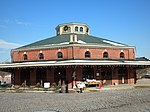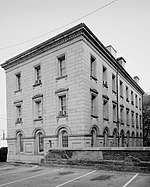Petersburg Union Station
Buildings and structures in Petersburg, VirginiaFormer Amtrak stations in VirginiaFormer Atlantic Coast Line Railroad stationsFormer Norfolk and Western Railway stationsHistoric district contributing properties in Virginia ... and 13 more
NRHP infobox with nocatNational Register of Historic Places in Petersburg, VirginiaPages with no open date in Infobox stationRailway stations in the United States closed in 1971Railway stations in the United States closed in 1977Railway stations in the United States opened in 1910Railway stations in the United States opened in 1975Railway stations on the National Register of Historic Places in VirginiaSouthern United States railway station stubsTransportation in Petersburg, VirginiaUnion stations in the United StatesVirginia building and structure stubsVirginia transportation stubs

Petersburg Union Station is a former train station in Petersburg, Virginia, United States. It was built in 1909–1910 for the Norfolk and Western Railway, and was later used by the Atlantic Coast Line Railroad and Amtrak.
Excerpt from the Wikipedia article Petersburg Union Station (License: CC BY-SA 3.0, Authors, Images).Petersburg Union Station
River Street, Petersburg
Geographical coordinates (GPS) Address External links Nearby Places Show on map
Geographical coordinates (GPS)
| Latitude | Longitude |
|---|---|
| N 37.234277777778 ° | E -77.402555555556 ° |
Address
Petersburg Union Station
River Street 103
23803 Petersburg
Virginia, United States
Open on Google Maps










